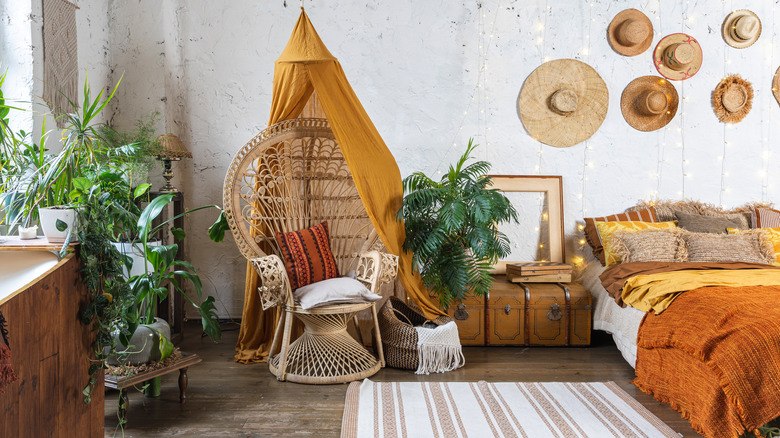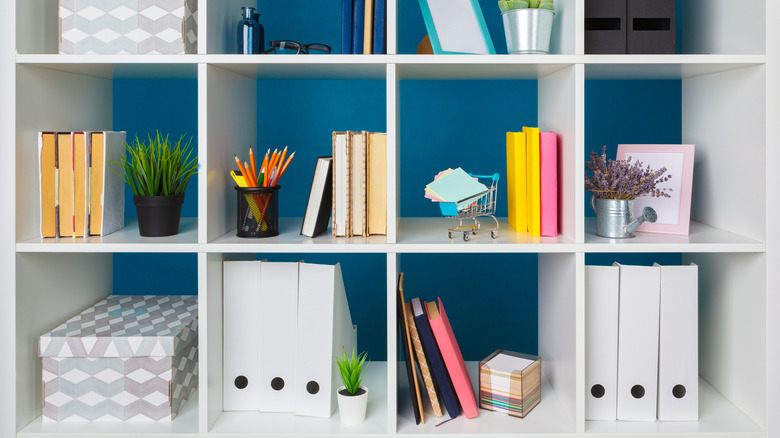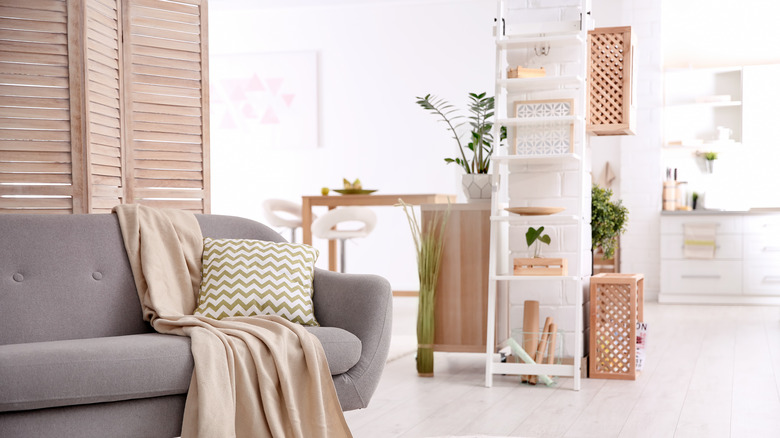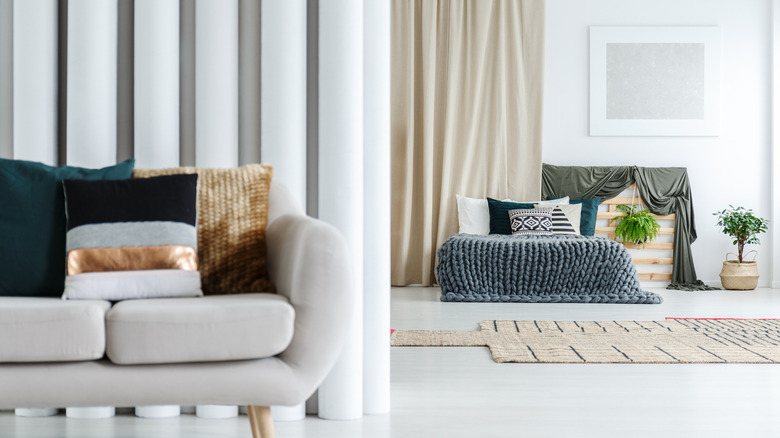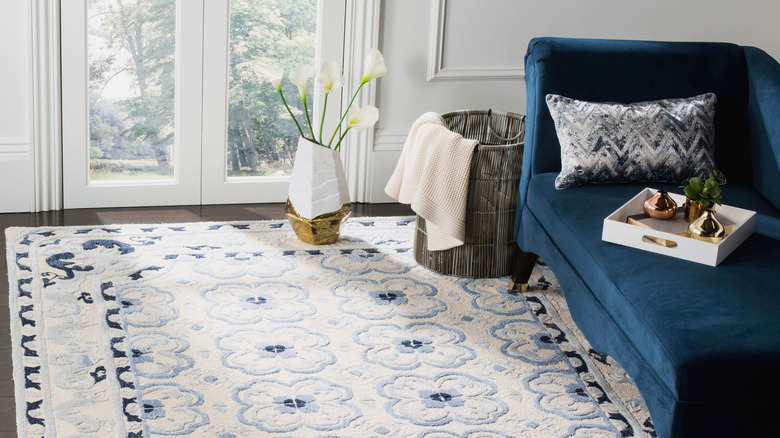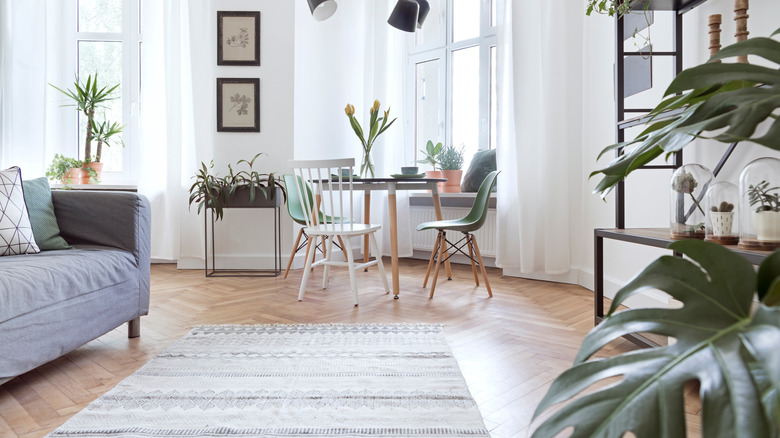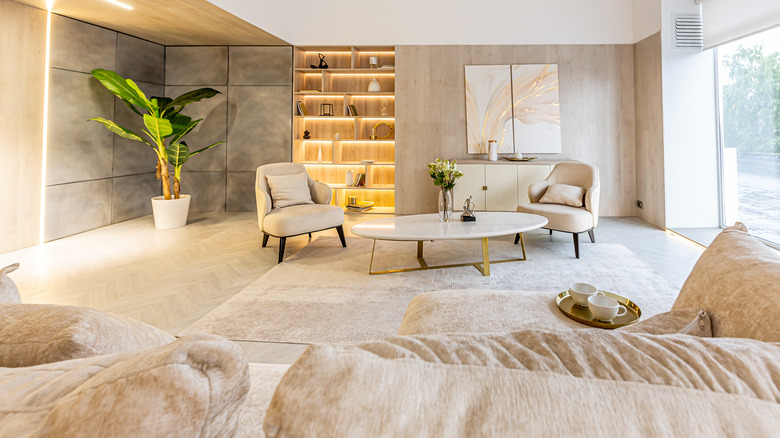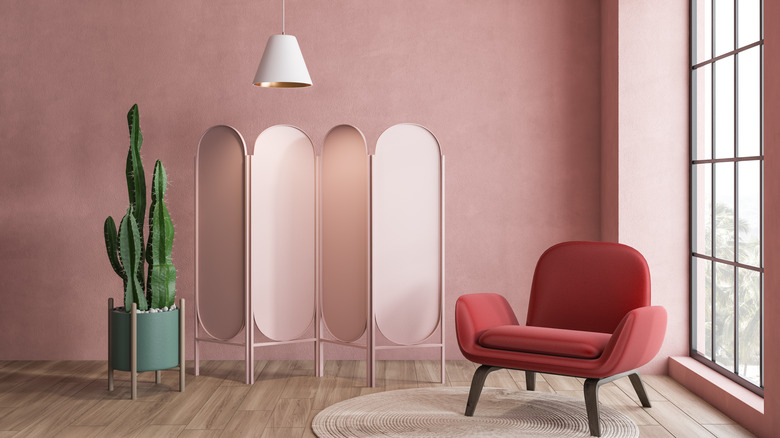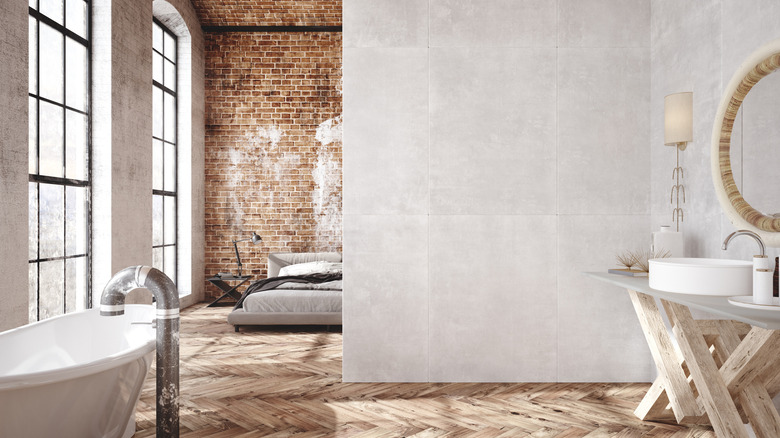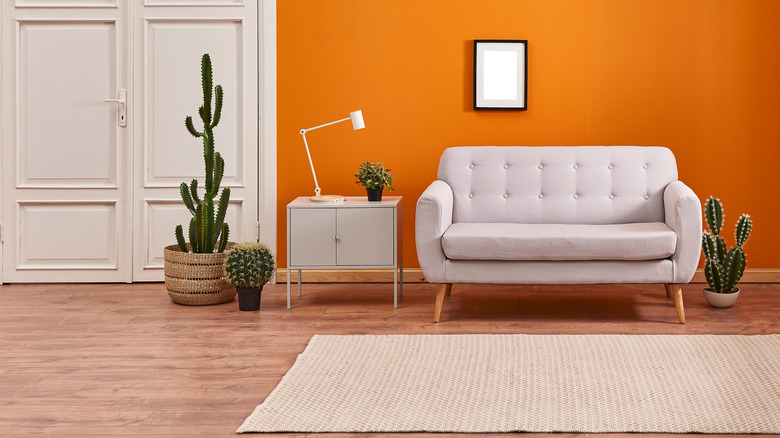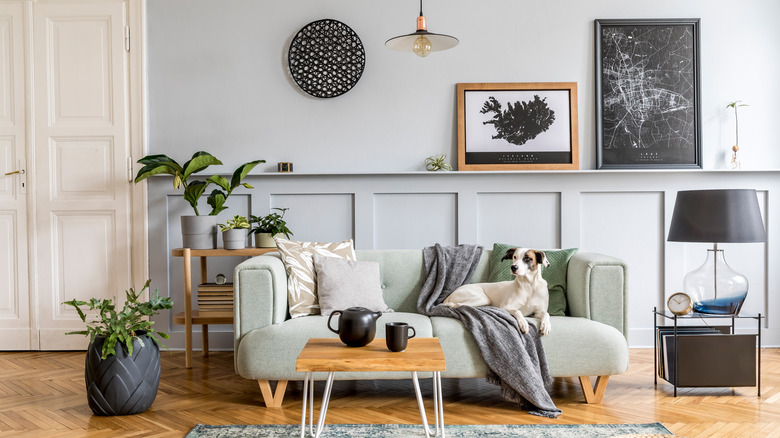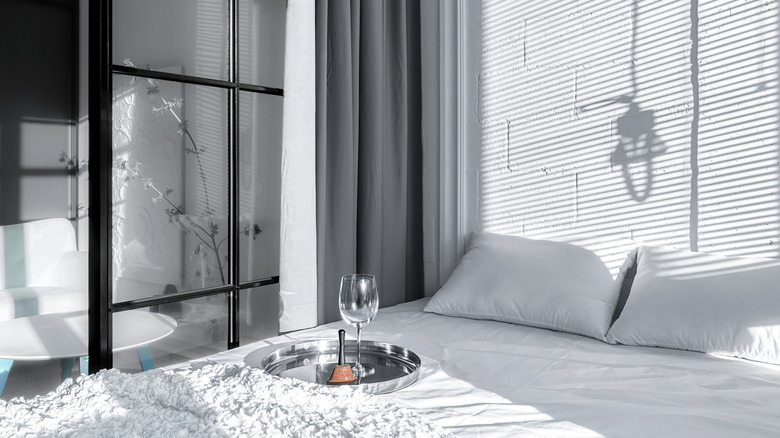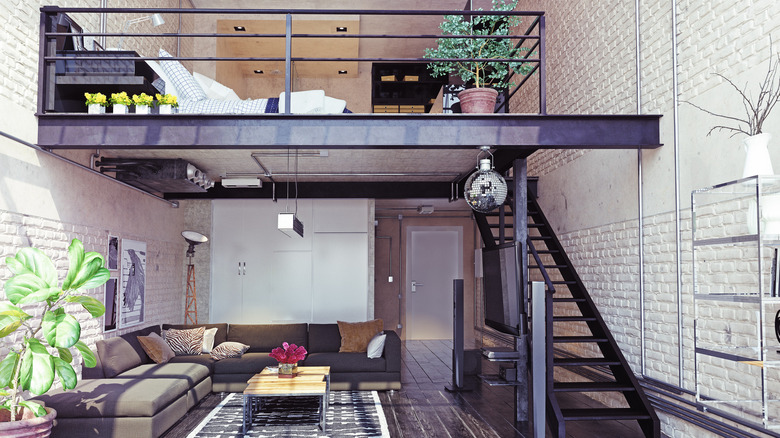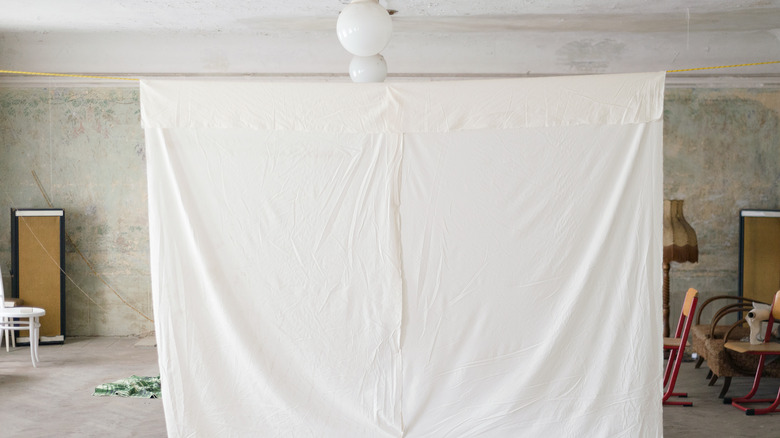15 Genius Tips For Dividing Rooms In A Studio Apartment
Many apartment dwellers opt to live in studio apartments, a type of apartment in which there are no separate rooms (apart from, typically, the bathroom). For many, this is a decision sparked by their budget, as rent prices for apartments with one or more bedrooms can be sky high in certain areas. Others value location, and would rather have a studio apartment in a walkable neighborhood than a larger apartment somewhere on the outskirts of the city they're dwelling in. Or, perhaps they simply want an environmentally-friendly space that costs less to heat, furnish, and requires less time to clean, as Apartment Ratings suggests.
Regardless of an individual's reason for choosing a studio apartment, however, there's one major reality: studio apartments can come with some serious design challenges, as Square Inch Home says. With everything remaining so open, it can be easy for your messy living room to encroach on your sleeping area, or for certain cluttered spaces to be visible from just about every place within your apartment. Finding ways to divide a studio apartment into different "rooms" or zones can be crucial — and often, it can be done with just a few relatively simple design hacks.
Here are 15 genius tips for dividing rooms in a studio apartment. They may not gain you any square footage, but they'll give your space a whole different feel.
1. Incorporate bookshelves as dividers
Bookshelves are one of the best ways to divide a studio apartment into "rooms," as MakeSpace explains. First of all, they act as an actual divider, segmenting your studio into different areas. They're also an item that many individuals already own, or can find at a low cost. They also provide added storage, always a bonus in a small space. Finally, there's a lot of variety — you can select the style, color, and shape that fits perfectly in your space.
2. Put up a divider that fits your apartment's aesthetic
You may not be able to erect full walls in your studio, but you can do the next best thing, which is to add divider screens in particular areas, suggests Square Inch Home. You can find options in whatever material you'd like, with whatever degree of opacity you prefer; dividers that are somewhat see-through can help to create different "rooms" within your studio without making the space seem smaller, as the eye can still travel through those barriers and process the full space.
3. Use curtains to divide the space
Textiles make a huge impact in a space, and if you're only using curtains as window coverings, you're overlooking a key function. As Apartment Therapy explains, curtains can help divide a space, either serving as a door or simply as a barrier. They can be easily pulled along a rod or line, so you can open up your full studio apartment when you want to, and draw the curtains when you want to create a more cozy "room" within the apartment. As an added bonus, curtains come in countless colors, prints, and textures, and typically won't break the bank.
4. Use area rugs to create particular zones
Area rugs add warmth, color or pattern, and texture to a space. However, they can also serve one more function, according to Square Inch Home: They can be incredibly helpful in creating different "zones" in a studio that function almost like rooms. Adding multiple rugs in a small floor plan may seem like overkill, but by including a different rug in the bedroom area, dining area, and living room area, you'll create a different feel and visual separation without having to add any walls at all.
5. Be smart with the positioning of your furniture
If you thought you had to line all your furniture up along the walls of your tiny studio apartment, think again — you can actually transform the space without even purchasing a single thing, simply with how you position your furniture, as Apartment Therapy explains. For example, by placing your couch near the foot of the bed in your "bedroom" area, you're essentially creating a divider that defines a "living room" space and a "bedroom" space, just with how you placed the key pieces of furniture.
6. Invest in versatile, multi-use furniture
While multi-use furniture can always be a plus, it can often be nearly essential when you live in a small space. You don't have to go out and buy all-new furniture, but when adding pieces to your apartment, consider whether you can find multi-use items. For example, as SpaceWise suggests, consider beds with storage drawers underneath or even a shelf or cabinet that features a fold-out table for dining. Multi-use furniture allows you to incorporate key pieces with a bit more flexibility, and to really make the most of the square footage you have available.
7. Reinvent a closet or two
If your entire studio apartment only has one closet, this might not be an option. However, if you're lucky enough to have a few small closets around the apartment, consider reinventing one of them to create a more functional space, as HGTV suggests. For example, instead of using that second closet to store random items you don't use on a regular basis, transform it into a tiny office zone with the addition of a few shelves, a simple desk, a lamp, and some curtains you can close when your workday is done.
8. Add a folding screen for a movable measure
As Apartment Therapy demonstrates, there are plenty of options on the market when it comes to foldable screens. For studio apartment dwellers who want the option of having a screen they can move around their space, rather than a more permanently installed divider screen, folding screens can be the perfect solution — just fold it closed and tuck it away when you don't want it, and quickly set it up when you want to conceal a particular area or divide the space in a different way.
9. Install a semi-transparent screen
For those who want to add a divider but hesitate to incorporate even a semi-transparent wall crafted from wood or another similar, more sturdy material, consider using screens instead, as Domino suggests. They can be ideal for spaces where you still want the light to be able to pass through, while still adding that feel of a "wall" dividing your studio apartment into different zones.
10. Create color zones in your space
If you don't want to add more furniture or any kind of physical barriers, don't worry — you can also achieve a sense of separation with just a splash of paint. One tip from Square Inch Home is to "color zone" your space, using either paint or wallpaper to create different "rooms" within the studio apartment. This technique will obviously depend on your layout, but even simply adding a statement wall here or there can help define what's functioning as your "bedroom" vs. your "living room," etc. It's an easy and inexpensive hack.
11. Artfully arrange décor pieces
If you don't want to add any type of screen or divider to your studio apartment, that's okay — there's another simple solution using the items you already have, according to Domino. You can arrange your décor pieces, such as a side table or large potted plant, in a way that creates a bit of a "barrier," making it seem as though you've divided a space into particular "rooms." It may feel strange for a few items to be floating along one side of your living room, but it can really help to define different "rooms."
12. Use floating art to create a decorative divider
Are you a huge art lover who simply isn't satisfied with the amount of wall space you have to display your creations? As House Beautiful recommends, do double duty by incorporating "floating" art. What this means is rather than putting all your artwork on the walls, you can use things like hooks and fishing line to suspend larger pieces in the air, effectively creating a divider of sorts that also introduces more gorgeous art into your space.
13. Consider a glass partition
If your studio apartment is super tiny and you really don't want to break up the space at all with visual dividers, consider incorporating a glass partition, suggests House Beautiful. Though you'll still be able to see all the areas of your apartment — and the light will shine through as if the partitions weren't even there — the simple addition of the glass panels can help create a visual divider that tricks your eye and makes it seem as though your apartment has been split into "rooms."
14. Go vertical rather than horizontal
This tip from HGTV does depend on the type of apartment you have and your ceiling height, but whenever possible in a small space, you should play around with going vertical as well as horizontal in the way you decorate and arrange things. One of the most common ways to use this trick in a studio apartment is by lofting your bed — by creating a structure that allows you to elevate your bed a bit, you can create a distinct "bedroom" area, as well as an additional area beneath it for storage, living, and more.
15. Use a projector screen
Calling all movie buffs (or Netflix bingers) — if you want to divide your studio apartment, but would also like a space to watch your favorite movies and shows, consider adding a projector screen, as The Spruce suggests. When not in use, it creates a simple yet effective visual divider that splits your studio apartment into rooms. It also serves multi-functional duty, and you won't have to figure out how to incorporate a large, bulky television somewhere in the space — just set up a projector and you're good to go.
